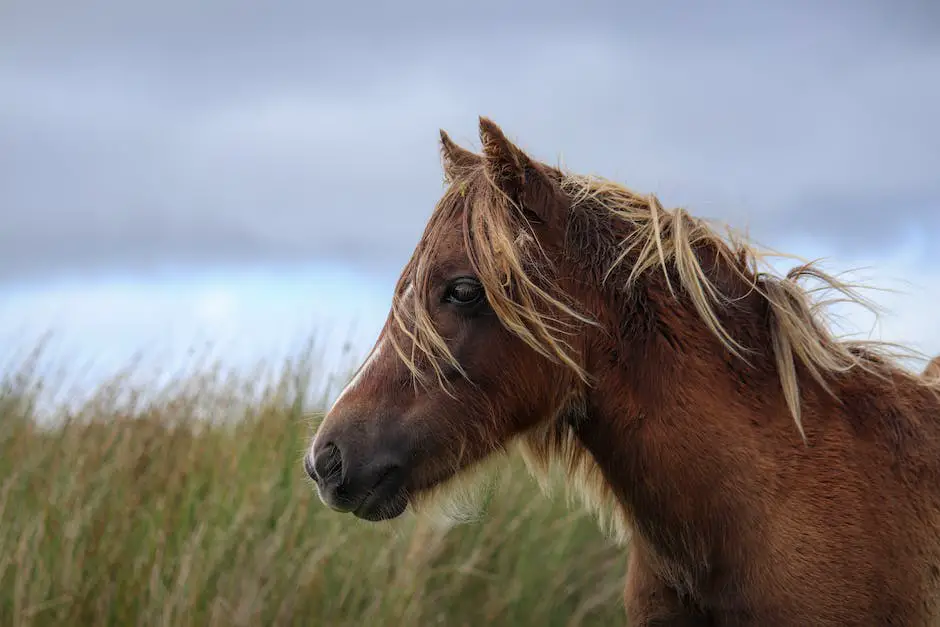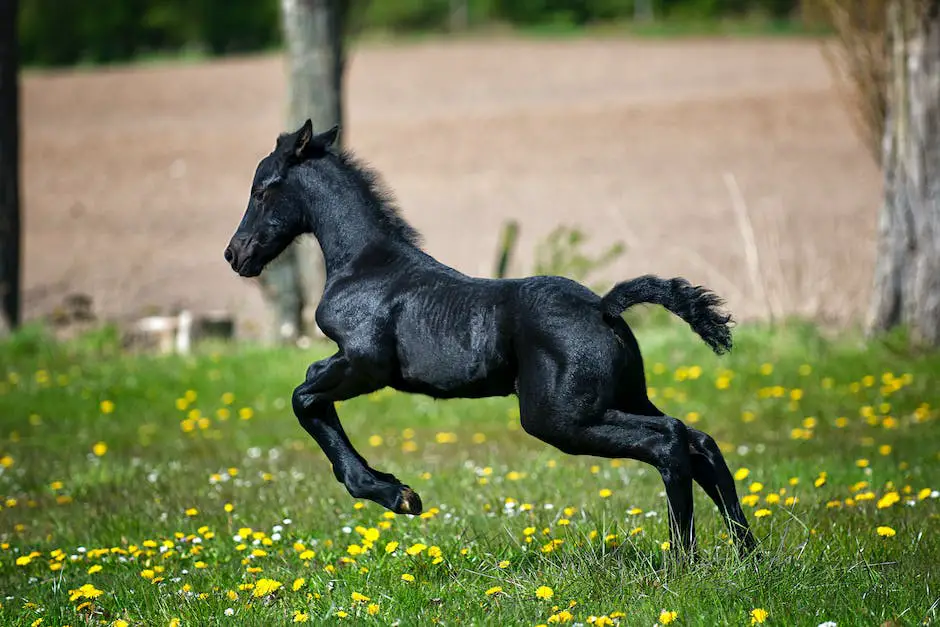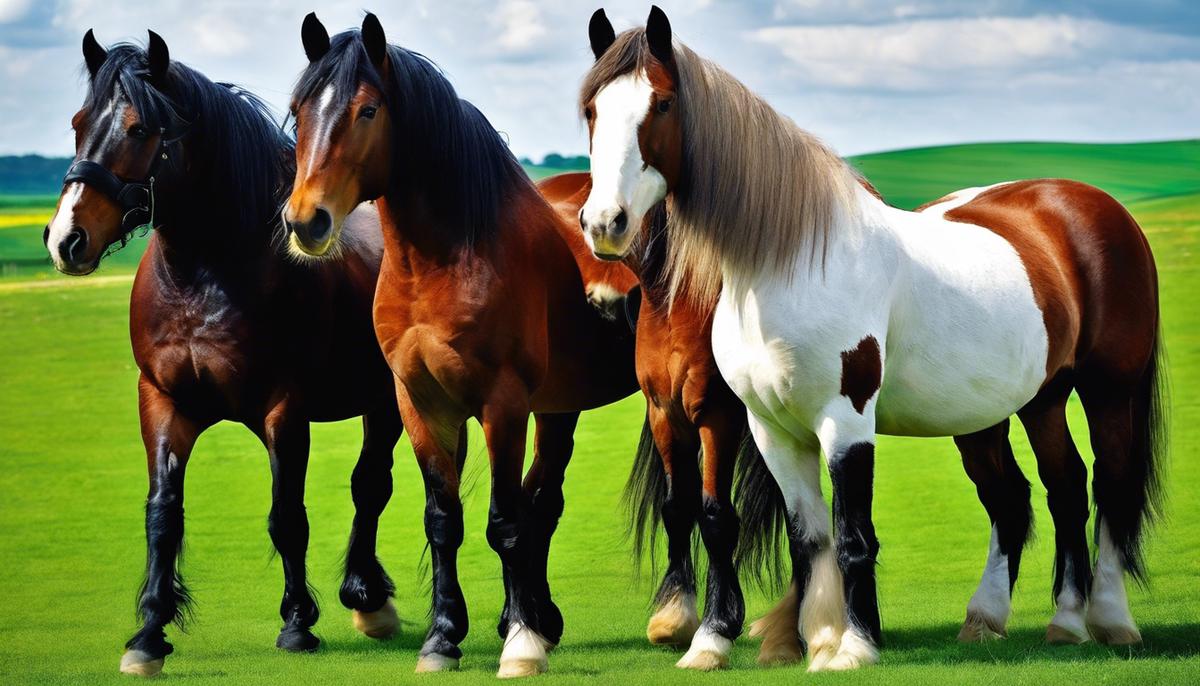In the verdant heartland of Brittany, France, exists a living testament to equine heritage—the Breton Draft horse. With roots entwined deeply in the rich tapestry of ancient history, this noble breed embodies the resilience and adaptability that have allowed it to weather the winds of change and emerge as a versatile contemporary working horse. Born of a lineage steeped in mystery and forged by the hands of time and human endeavor, the Breton Draft horse’s journey from antiquity to present serves as a compelling narrative of survival and evolution. To truly appreciate the Breton Draft, one must embark on a quest through the annals of time to uncover the intricate weave of events and breeding that has culminated in the robust, amiable giant of today—a breed that continues to leave an indelible hoof print across the fields and hearts of those it serves.
Table of Contents (Horspedia)
History and Origin of Breton Draft Horses
The Sturdy Tale of the Breton Draft Horses
Ever marveled at the sight of a Breton draft horse? These magnificent beasts aren’t just another pretty face in the paddock. There’s a rich history hoofing it alongside every Breton that trots!
This chunky breed hails from Brittany, a region in northwest France. Now, sit tight, because their story is as fascinating as their gait is steady.
It all began back in the medieval days. Imagine knights in shining armor; now picture the mighty horses they rode. Yep, those were the ancestors of today’s Breton horses! The horses from that time were bred for the strength needed in battle and to carry fully armored warriors. Heavy stuff, right?
As time trotted on, the horse’s ancestors, including the Bidet (once upon a forgotten age, it was a smaller type from Brittany) started mingling with horses brought back by the crusaders and other imports from places like Britain. This melange of equine genetics was the beginnings of the Breton’s roadmap.
Fast forward to the 19th century. Agriculture is the name of the game, and horsepower equates to your farm’s actual power. The Breton horses were crossbred with other draft breeds, such as the Percheron and the Ardennais, to enhance their muscle and stamina for farming and hauling. This selective dabbling in the genetic pool created a horse that is equal parts brawn and beauty.
Standing at about 1.5 to 1.6 meters tall (that’s around 15 to 16 hands for the horsey crowd), these horses are shorter than some of their draft cousins but don’t let that fool you. What they might lack in height, they make up for in muscular prowess and a gentle, people-pleasing temperament.
The color wheel of Breton horses can land on anything from chestnut to roan, with flashy flaxen manes and tails that whip in the wind. Don’t be surprised to spot a blond Breton — their golden locks are pretty much legendary!
Today’s Breton horses still do farm work, but they’re also superstars in pulling competitions and a favorite for those who love a solid, reliable ride. Even on the dinner plate – yes, in some places these beautiful horses are raised for meat – they carry a presence that’s hard to ignore.
And so, from brawny battlefield companion to modern-day working hero, the Breton draft horse has etched its hoofprints deeply into the earth and into the hearts of those who appreciate the might and spirit of this remarkable breed. No wonder Breton horses are touted as living legends of equine excellence – their history is as sturdy as they come, and their future seems just as strong.

Photo by aleskrivec on Unsplash
Characteristics and Physical Traits
Diving into the distinct features of the Breton Draft horse, it’s essential to note these robust animals have a look and character that set them apart. When encountering a Breton Draft, one can’t help but be captivated by their unique appearance: stout and powerful, these horses have muscular shoulders and broad chests, a testament to their strength. Typically standing at about 1.55 to 1.63 meters (15-16 hands), they present a compact silhouette with well-rounded hindquarters.
Their coats shine with various shades ranging from chestnut and bay to roan, with the chestnut ones sporting a flaxen mane and tail, adding to their eye-catching form. A signature trait, the Breton’s head is relatively short with expressive eyes which seem to convey their gentle nature.
Speaking of temperament, here’s a horse that practically embodies the term “gentle giant.” The Breton is known for having an even-tempered disposition, a trait highly prized by those who work with them. They tolerate the hustle of farm life and the focus required in competitive pulling with an unflappable calmness. It’s their calm demeanor coupled with a willingness to work that makes them excellent for beginners and experts alike.
When you’re looking for a working partner, the Breton’s cooperative spirit shines. They are quick to learn and eager to please, reacting well to training and forming strong bonds with their handlers. This agreeableness, however, does not dilute their zest for work; Breton horses have an impressive work ethic and stamina, making them as diligent in their labor as they are easy to manage.
So, whether you’re at a farming event, a draft horse competition, or just appreciating these mighty creatures in their natural habitat, the Breton Draft horse stands out. Its mix of power and placidity has not only sculpted its physical attributes but also crafted the incomparable temperament that has endeared the breed to enthusiasts for centuries.

Uses and Roles of Breton Horses Today
A Gallop into Modern Roles: The Breton Draft Horse at Work Today
Today’s world is a fast-paced, technology-driven place where horsepower often refers to engines and machinery. But there’s still a special role for the Breton Draft horse, a breed that offers more than just brawn. These horses are known for their strength and calm nature, making them perfect for a variety of jobs beyond the farm.
One of the main modern uses for Breton Draft horses is in forestry. Their power and agility are unmatched when it comes to navigating through dense woods. They’re environmentally friendly loggers, as they don’t damage the forest floor the way heavy machinery does. With the world becoming more eco-conscious, employing Breton horses for low-impact logging has gained popularity among those seeking sustainable forestry methods.
Another field where Bretons shine is in therapeutic riding programs. Their calm demeanor and patient attitudes make them exceptional partners for individuals with special needs. Working with horses is known to improve mental health, and Bretons offer just the right mix of gentleness and steadiness for many therapeutic riding participants.
In urban settings, Breton Draft horses often dazzle crowds in parades and ceremonial events. Their commanding presence and stylish gaits make them a favorite for pulling historic carriages or participating in honor guard ceremonies. They carry on traditions and represent history in motion, connecting us to our past with every hoofbeat.
In the realm of leisure, Breton horses have found their niche in recreational riding and driving. While they may be draft horses, they’re also quite suitable for pleasure drives in the countryside. Families or hobbyists who enjoy the thrill of horseback riding or the charm of a horse-drawn wagon often choose Bretons for their versatility and reliability.
Lastly, while it may be a tough topic, it’s important to acknowledge that some Breton horses are still raised for meat. However, there’s a movement among equestrian enthusiasts to shift the focus from this practice towards recognizing and expanding the breed’s abilities in live settings.
The Breton Draft horse continues to prove its worth and adaptability in our contemporary world. From responsible forestry to celebrating traditions, and from therapeutic work to leisure, these powerful yet gentle giants show us that some old-world charms will never go out of style. Whether one admires their strength in a pulling competition, enjoys a peaceful ride, or benefits from their therapeutic presence, Breton Draft horses still capture hearts and fulfill roles that go beyond the scope of what machines can offer. Their hoofprints make impressions not just on the land, but also on the lives of people around the world.

Breeding and Conservation
Preserving the Past, Galloping Towards the Future: The Breton Draft Horse Endeavor
Amid modern advancements, it’s refreshing to find a deep appreciation for the storied Breton Draft horse. This majestic breed, renowned for its strength and versatility, is not just a relic of the past but a living testament to equestrian resilience. The question begs, though – with a decline in traditional farming, what’s being done to preserve and enhance the Breton Draft horse breed?
Conservation efforts are in full swing to ensure the survival and improvement of the Breton Draft Horse. Breeder associations play a crucial role, maintaining stud books to record and monitor purebred horses. These registries help breeders make informed choices, combining the finest traits to produce robust offspring that stay true to the breed’s legacy.
To expand the genetic diversity without altering the core characteristics of the Breton, some ingenious crossbreeding with other draft breeds is undertaken. This increases their resilience against diseases and can enhance certain traits to suit contemporary needs without sacrificing their heritage. Moreover, breeders focus on adapting to market demands, aiming to create a horse that excels not just in strength but also in agility and temperament.
Education campaigns are another powerful tool. By boosting the breed’s profile through online platforms, shows, and local events, organizers attract new enthusiasts and inform the public about the Breton’s capabilities beyond agriculture. Riding schools and equestrian clubs often showcase Bretons in action, highlighting their gentle nature and their suitability for various equestrian disciplines.
Sustainability plays a crucial role, too. Some have turned toward eco-friendly farming practices where the Breton Draft horse is more than just a historical figure – it’s part of a solution. Their lighter footprint compared to heavy machinery makes them excellent companions for organic farmers, and yes, they’re great for vineyard work too!
Furthermore, continental Europe, where they are often raised for meat, sees a shift as animal welfare groups rally for more humane treatment of these equines. Valued as sentient beings, they inspire legislation changes and captive breeding programs that prioritize quality of life.
“Adopt a horse” programs have surfaced, where anyone passionate can sponsor a Breton Draft. These schemes ensure the care and preservation of individual horses, with sponsors often getting a chance to interact with their chosen horse, creating heartfelt connections that ensure a vested interest in the breed’s well-being.
Finally, scientific research is not left out. Genetic studies focus on pinpointing characteristics for longevity, disease resistance, and breeding soundness. Technology tags along, offering tools like DNA testing to maintain the authenticity of the breed’s lineage.
It’s clear – the crossroads of tradition and innovation mark the path for the Breton Draft horse’s survival. Through conscious collaborations among breeders, enthusiasts, scientists, and the broader community, the charm and value of the Breton Draft horse gallop forward, ensuring this magnificent animal strides well into the future, pulling more than a plow but the hearts of those who treasure them.

The Breton Draft horse endures as a prominent figure in the tapestry of equestrian breeds, not merely for its storied past, but for the bright future it holds within an evolving world. As breeders and enthusiasts alike blend the wisdom of tradition with the innovation of modern science, this majestic breed stands ready to gallop into new horizons. Armed with an intimate understanding of its tale, from the battlefields of yore to the tranquil countrysides it now graces, we are afforded the privilege of shaping a legacy that honors the magnificence of the Breton horse. As the sun sets upon our exploration of this equine treasure, we are left not with a conclusion but with an enduring commitment—an unwavering resolve to ensure the vibrant continuation of the Breton horse line for generations to come.

